Background
Fertagus originally received a 30-year concession to operate the "Eixo Norte-Sul" (north-south axis) railway line between Lisbon Entrecampos and the south bank of the river Tagus, via the Ponte 25 de Abril (25th April Bridge). However, in 2005, the concession was reduced to a total of 11 years with an option on a further nine, following disppointing traffic figures (30% below target). The French company, Vivendi, the Portuguese bus company, Barraqueiro, and the bank, Caixa Geral de Depósitos, are major shareholders in Fertagus. Vivendi are also owners of the Lisbon suburban bus operator, Barraqueiro.
Although the 25th April bridge was opened on 6 August, 1966 as a road link, it had provision from its inception for a rail deck at a lower level. This rail facility was not actually made usable until 1999 when Fertagus started cross-river services. The conversion work on the rail-deck of the bridge had started in 1996 and cost 150,000,000,000 escudos (over £450M). 700 men were employed both to prepare the train deck and to widen the road deck. 20,000 tonnes of steel were required and 85,000 cubic metres of concrete were used for these works.
Work on the south bank included a 280 metre tunnel near Pragal and a 124 metre tunnel at Feijó. A number of concrete viaducts were also constructed, the most notable being the 1,485 metre long viaduct at Corroios.
Rolling Stock
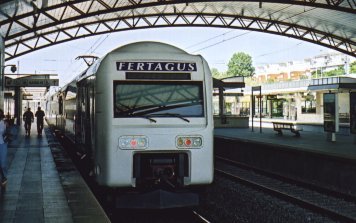 Eighteen four-car double-deck electric multiple-units (EMU) sets were ordered from GEC Alsthom by Fertagus for this route, with the Spanish (RENFE) class 450 being the basis of their design. They were built in Barcelona and their capacity is 1200 passengers per train. By November 1999, six of the eleven sets of four-cars delivered were bearing advertising liveries. All eighteen sets had been acquired by late 2000 and the majority of these train-sets initially surrendered their smart blue and white livery to commercial advertisers, a trend which had been arrested by 2005.
Eighteen four-car double-deck electric multiple-units (EMU) sets were ordered from GEC Alsthom by Fertagus for this route, with the Spanish (RENFE) class 450 being the basis of their design. They were built in Barcelona and their capacity is 1200 passengers per train. By November 1999, six of the eleven sets of four-cars delivered were bearing advertising liveries. All eighteen sets had been acquired by late 2000 and the majority of these train-sets initially surrendered their smart blue and white livery to commercial advertisers, a trend which had been arrested by 2005.
Left: Fertagus service at Pragal.
Fertagus's EMU sets are stabled at Coina and the line was extended beyond there in 2003. The train interiors are attractively designed with blue patterned seats and other features include air conditioning, smoked windows and digital displays of ambient temperatures. In summer 2000 Fertagus was reported to have ordered some five-car sets to deal with the increased traffic resulting from extension of the line but these did not materialise and the 18 sets now have to operate the extended network which limits services, especially to Setúbal.
Network
The cross-Tagus facility effectively links central Lisbon with the southern Portuguese main line, without the need to use the ferry which runs from the capital across the Tagus to Barreiro from wher trains run to the Alentejo and Algarve regions.
Until September 2003, the Lisbon terminus of Fertagus was at Entrecampos but it has since moved slightly further east to Roma/Areeiro, which is a transformed and enlarged version of the former small CP (Portuguese Railways) station at Areeiro. The Fertagus south-bank services were extended in October 2004 via Palmela as far as Setúbal (54km, journey time 57 mins), but the primary commuter service is to Coina, some 27km from Roma/Areeiro station in Lisbon across the bridge.
The long-awaited CP Lisbon to Faro service started on 24 July 2003 initially using diesel traction. The Algarve link involved the redevelopment of Pinhal Novo as a junction with the existing CP lines from Barreiro to southern Portugal. A new rail bridge linking Chelas to a point just east of Barreiro has also been mooted but not materialised. If built, this would mean that Pinhal Novo would become a major junction with the Fertagus line reaching it from the west and the new-bridge line joining it from the north.
Although there has long been a sizeable traffic in commuters from the 'Outra Banda', the south bank of the Tagus, into Lisbon, the Fertagus line is stimulating further such traffic by prompting more residential and commercial development on the south side of the river. Most of the new Fertagus stations have been characterised by adjacent shopping centres of varying sizes and large car parks for commuters.
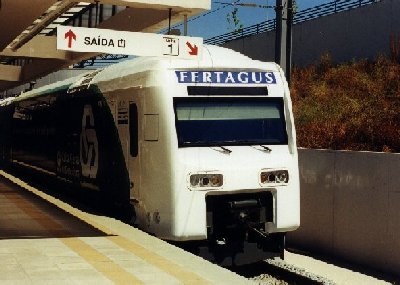
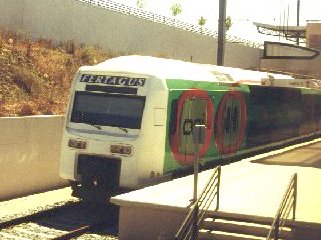 Left and right: Fertagus services at Fogueteiro, July, 2000.
Left and right: Fertagus services at Fogueteiro, July, 2000.
Of the journey time of 33 minutes for the 27 km between Roma/Areeiro and Coina, 7 minutes are assigned to the mandatory, slow cross-river section between Campolide and Pragal. On the bridge a 60km/hr limit applies; otherwise, stock may run at up to 140km/hr. The adult fare is (2019) 4.55 Euros for single tickets between Lisbon and Setúbal. Tickets must be cancelled in machines before boarding the train as they are then used to operate exit turnstiles at each station. At the joint CP/Fertagus stations, tickets for the service can only be bought from Fertagus and not at the CP ticket-offices but Fertagus ticket machines are also available. Fertagus's punctuality and reliability are both very good. Trains to Coina ran every 10 minutes at peak times and every 20 at other times. Services to Setúbal are half-hourly in peak hours and hourly otherwise.
As of 12 August 2008, Fertagus introduced ticketing with the 7 Colinas and the Viva Viagem cards to replace the single/return/10-trip tickets.
The first Fogueteiro-Entrecampos service ran on 30 July 1999 and, by the first anniversary, the line had carried sixteen million passengers. By July 2000 loads were approximately 50,000 people per day and in 2005 were c70,000. Surveys have shown that the Fertagus route is impacting more on the ferry services than on the road bridge with the majority of passengers using period-passes, rather than individually purchased tickets. Connecting bus services are run by Sul-Fertagus and TST from all of the southern stations but seem little used outside working hours. However, by May 2001 Fertagus admitted that it had carried only 57.5% (11.5 million) of its forecast number of passengers and recorded a loss of 7 million Euros on a turnover of 11.5 Euros.
For further information on the 25th April bridge, see theLisbon Bridges page of this site.
The Route Described: Roma/Areeiro to Setúbal
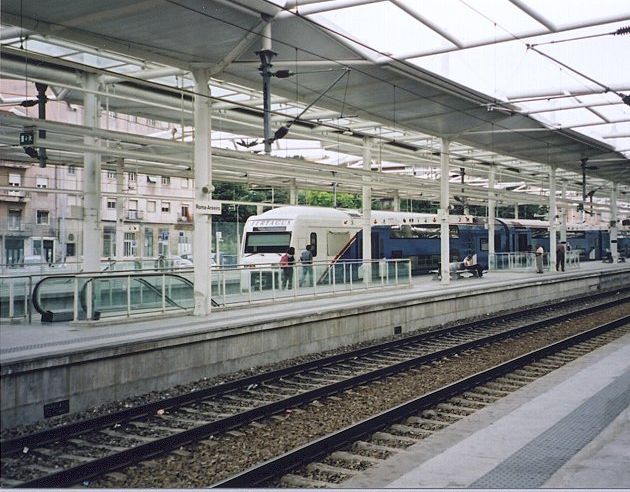
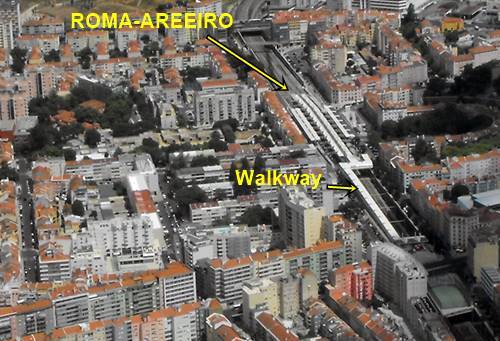
Above, left: Roma-Areeiro station with a Fertagus service awaiting departure. Right: Aerial view of Roma-Areeiro shpowing the walkway towards the Metro connection. The platforms of the former Apeadeiro Areeiro railway halt were a little further towards the top of the image from the current Roma-Areeiro station platforms before being remodelled. Roma Metro station is towards the bottom of the image, left of centre.
 ROMA - AREEIRO
Roma-Areeiro became the new Lisbon terminus for Fertagus services c2004. The station itself is a modern enlargement of the formerly small station called Areeiro. By building a long walkway (with moving walkways), with an entrance on the Avenida de Roma (less than five minutes walk, above ground, from Roma Metro station), the new facility can claim to serve both Roma and Areeiro as it is also about a five minute walk from Areeiro Metro station. The modern station now has four tracks (P2P2) and continues to operate as a station on the Sintra line as well. The train runs along a shallow cutting through unremarkable urban scenery for the short distance from Roma/Areeiro to the original starting point of Fertagus services at Entrecampos.
ROMA - AREEIRO
Roma-Areeiro became the new Lisbon terminus for Fertagus services c2004. The station itself is a modern enlargement of the formerly small station called Areeiro. By building a long walkway (with moving walkways), with an entrance on the Avenida de Roma (less than five minutes walk, above ground, from Roma Metro station), the new facility can claim to serve both Roma and Areeiro as it is also about a five minute walk from Areeiro Metro station. The modern station now has four tracks (P2P2) and continues to operate as a station on the Sintra line as well. The train runs along a shallow cutting through unremarkable urban scenery for the short distance from Roma/Areeiro to the original starting point of Fertagus services at Entrecampos.
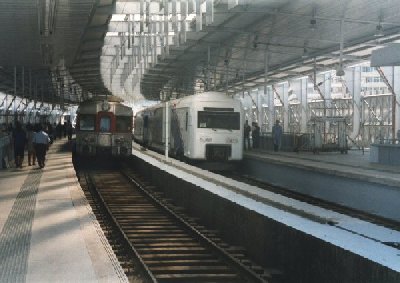
 ENTRECAMPOS Entrecampos can be reached by CP trains from Oriente, as well as by Metro- for further details see the Luso Pages Railways Page. Both CP and Fertagus services use the station, though the latter's ticket office is poorly signposted. In fact, both companies share a facility on the level below the platforms. Fertagus trains use the platforms on the south side of the station and on departure these immediately pass Entrecampos-Poente, the terminus for the some of the services on the Sintra Line, which lie over to the right. The north side of Entrecampos station is used by CP services which include Azambuja Line trains to 08:33 04/07/2005and from Oriente and Alcântara-Terra and Sintra Line services. Some of CP's Alfa Pendular services from Faro in the Algarve also use Entrecampos.
ENTRECAMPOS Entrecampos can be reached by CP trains from Oriente, as well as by Metro- for further details see the Luso Pages Railways Page. Both CP and Fertagus services use the station, though the latter's ticket office is poorly signposted. In fact, both companies share a facility on the level below the platforms. Fertagus trains use the platforms on the south side of the station and on departure these immediately pass Entrecampos-Poente, the terminus for the some of the services on the Sintra Line, which lie over to the right. The north side of Entrecampos station is used by CP services which include Azambuja Line trains to 08:33 04/07/2005and from Oriente and Alcântara-Terra and Sintra Line services. Some of CP's Alfa Pendular services from Faro in the Algarve also use Entrecampos.
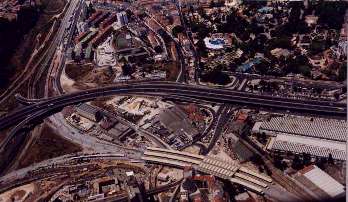
 SETE RIOS (P2P2P) Sete Rios station, seen in the adjacent aerial view, is an interchange station for CP suburban services on the Sintra line and also now is adjacent to the city's main coach station (to the right). Fertagus services share this station with CP trains. It is a modern, rebuilt station at whose western end (left) can be seen a stretch of the Lisbon aqueduct, built in the 18th century. Modern flats adorn the view to the right, whilst the left, as the station is left towards Sintra is more open, with scrubland. Sete Rios is the location of the Lisbon Zoo and there is also a nearby link to the Metro system at the Jardim Zoológico station. On the left of the Fertagus track were the former sheds of the Metro.
SETE RIOS (P2P2P) Sete Rios station, seen in the adjacent aerial view, is an interchange station for CP suburban services on the Sintra line and also now is adjacent to the city's main coach station (to the right). Fertagus services share this station with CP trains. It is a modern, rebuilt station at whose western end (left) can be seen a stretch of the Lisbon aqueduct, built in the 18th century. Modern flats adorn the view to the right, whilst the left, as the station is left towards Sintra is more open, with scrubland. Sete Rios is the location of the Lisbon Zoo and there is also a nearby link to the Metro system at the Jardim Zoológico station. On the left of the Fertagus track were the former sheds of the Metro.
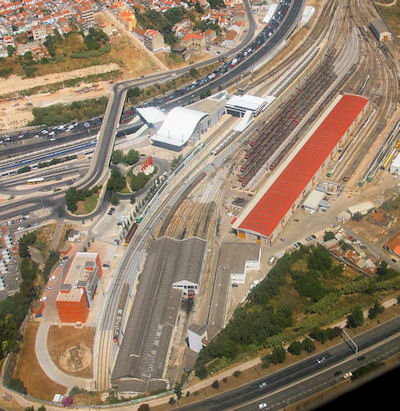
 CAMPOLIDE (P2P) The cross-Tagus line uses the western side of this recently rebuilt station, with CP suburban services using the rest of the facility. A blue Fertagus train on this alignment can be seen in the upper left of the adjacent photo. CP sidings (on right in photo) house Sintra Line class 2300 and 2400 EMUs as well as class 3500 double-deck stock. The train passes under the magnificent 18th-century Aqueduto das Águas Livres (Free Waters Aqueduct) before passing a shabby area of shanties to the left. However, modern flats are also being erected nearby. The line also goes under the Viaduto Duarte Pacheco which carries road traffic towards the bridge area. The train passes through short, new platforms at an as yet unused halt (Alvito).
CAMPOLIDE (P2P) The cross-Tagus line uses the western side of this recently rebuilt station, with CP suburban services using the rest of the facility. A blue Fertagus train on this alignment can be seen in the upper left of the adjacent photo. CP sidings (on right in photo) house Sintra Line class 2300 and 2400 EMUs as well as class 3500 double-deck stock. The train passes under the magnificent 18th-century Aqueduto das Águas Livres (Free Waters Aqueduct) before passing a shabby area of shanties to the left. However, modern flats are also being erected nearby. The line also goes under the Viaduto Duarte Pacheco which carries road traffic towards the bridge area. The train passes through short, new platforms at an as yet unused halt (Alvito).
To the right can be seen the compact Tapadinha athletics stadium before the train moves on to the Ponte 25 de Abril. There are magnificent views left towards Lisbon, with the Carris tram depot immediately below the line, and up the Tagus towards the Ribatejo, whilst to the right can be seen the 16th-century Torre de Belém and the Padrão dos Descobrimentos (Monument to the Discoveries) at the river edge. Photography from the train is difficult, however, because the train deck is partly enclosed by girders along its full length. As the train approaches the south bank, good views of the tall Cristo-Rei (Christ the King) monument at Almada can be seen to the left, before the train enters a short tunnel which goes under the toll booths of the road level of the bridge. Just before arriving at Pragal the new Metro do Sul do Tejo tracks cross beneath the Fertagus tracks.
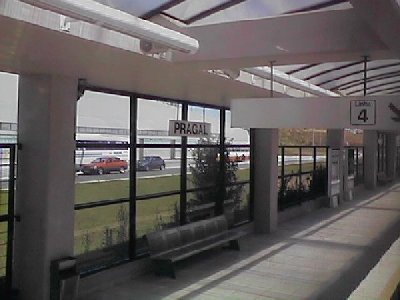
 PRAGAL (P2P2P) Seven minutes from Campolide, and only a short distance across the river, is the station of Pragal, which is also used by one or two CP services to Oporto. The station, built for the line's opening, is decorated by modern ceramic designs.
PRAGAL (P2P2P) Seven minutes from Campolide, and only a short distance across the river, is the station of Pragal, which is also used by one or two CP services to Oporto. The station, built for the line's opening, is decorated by modern ceramic designs.
The station lies next to the IC20 road on the left and has a car-park for 1800 vehicles. Adjacent is a 'Galeria Comercial', or shopping precinct, of 40 shops and bus stops for connecting services operated by Sul-Fertagus and TST. Amongst the bus services are ones to the beaches of the Caparica area. To the left can be seen, in the distance, the Margueira ship-repair yards of Lisnave, near Cacilhas. The line runs along a concrete viaduct out of Pragal and loops east over the IC20 then under the busy A2 motorway before running alongside this same road, on its left-hand side. Pictured, left, is a north-bound platform.
There is a pleasant café just outside the southbound side of the station called the Verde-Amarelo, from whose terrace the trains can be watched as they loop away from Pragal on a viaduct. To the right the Metro do Sul do Tejo line heads to the right on a viaduct.
 CORROIOS (P2P) After passing through a short tunnel, the town of Corroios can be seen to the left of the train which is still at a slightly higher level than the parallel road (right) at this point. Buildings are now also evident to the right where a large car-park can also be seen (for 1500 vehicles). Corroios station is entered five minutes after leaving Pragal. Sul-Fertagus and TST buses also serve this station, which has ten shops.
CORROIOS (P2P) After passing through a short tunnel, the town of Corroios can be seen to the left of the train which is still at a slightly higher level than the parallel road (right) at this point. Buildings are now also evident to the right where a large car-park can also be seen (for 1500 vehicles). Corroios station is entered five minutes after leaving Pragal. Sul-Fertagus and TST buses also serve this station, which has ten shops.
From 1 May 2007 an added link came in to service when the Metro do Sul do Tejo opened. This nowadays provides tram services to Cacilhas, Almada and the University at Caparica but, by the summer 2007, it had reached only as far as Cova da Piedade. Beyond the station on the left are various small-scale industrial plants including a cork processing works and a Toyota facility. Another large car-park on the left and the Seixal stadium, preface the train's arrival at Foros de Amora, just three minutes after leaving Corroios. Behind lie the Tagus bridge and Cristo Rei statue on the left.
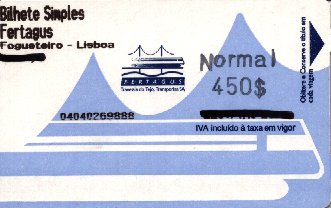
 FOROS DE AMORA (P2P) The railway is now back at street level at this high-roofed and airy station, decorated with marble and tiled walls. The motorway is to the right, parallel with the line. TST and Sul-Fertagus buses again stop outside the station, which has 23 shops and 1800 parking spaces. The town of Amora lies over to the left, on the Tagus. A tall water tank, emblasoned with 'Foros de Marinha' stands out to the left, as does a McDonald's fast-food outlet at a motorway service area to the right. Lisbon can be seen in the distance to the left.
FOROS DE AMORA (P2P) The railway is now back at street level at this high-roofed and airy station, decorated with marble and tiled walls. The motorway is to the right, parallel with the line. TST and Sul-Fertagus buses again stop outside the station, which has 23 shops and 1800 parking spaces. The town of Amora lies over to the left, on the Tagus. A tall water tank, emblasoned with 'Foros de Marinha' stands out to the left, as does a McDonald's fast-food outlet at a motorway service area to the right. Lisbon can be seen in the distance to the left.
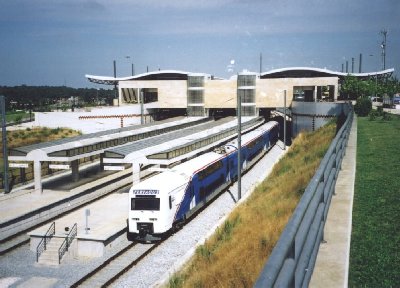
Left: Old style Fertagus ticket from pre-Euro days in Portugal.
 FOGUETEIRO (1P1P1) After leaving Foros de Amora, the line diverges from the A2 motorway as the track veers left. After two minutes, Fogueteiro station is reached. This was the terminus until 2004. The station itself is spacious, with a striking wavy roof and includes a café, news-stand and toilet facilities. There is also a Fertagus information desk. Across the road from the station are some steps to a commercial centre which includes a café overlooking the attractive station. After leaving Fogueteiro, via a small cutting, the train sweeps left, past a Sagres beer depot and semi-industrial landscape. On the left are the Fertagus sheds and sidings as the train nears Coina.
FOGUETEIRO (1P1P1) After leaving Foros de Amora, the line diverges from the A2 motorway as the track veers left. After two minutes, Fogueteiro station is reached. This was the terminus until 2004. The station itself is spacious, with a striking wavy roof and includes a café, news-stand and toilet facilities. There is also a Fertagus information desk. Across the road from the station are some steps to a commercial centre which includes a café overlooking the attractive station. After leaving Fogueteiro, via a small cutting, the train sweeps left, past a Sagres beer depot and semi-industrial landscape. On the left are the Fertagus sheds and sidings as the train nears Coina.
 COINA (1P2P1)
This is the terminus for most services, though some run on to Setúbal. In the distance (right) can be seen the hills towards Palmela. The train passes through a short tunnel before passing factory sidings (right). A line joins from the right before the train reaches Penalva.
COINA (1P2P1)
This is the terminus for most services, though some run on to Setúbal. In the distance (right) can be seen the hills towards Palmela. The train passes through a short tunnel before passing factory sidings (right). A line joins from the right before the train reaches Penalva.

 PENALVA (P2P)
This is another modern, high-roofed station with a large car-park which, as well as its Fertagus tracks under cover, also has four open-air tracks passing the station to the right. These external lines reduce to one as the train gets beyond Penalva and goes through a mixture of scrub, light industry and intermittent housing, with the town of Penalva on the left. To the right, the castle at Palmela is visible on the hill top. Now just twin-tracked again, the line passes cork trees (right) before approaching the sizeable town of Pinhal Novo, before which more lines join from the left- these come from Barreiro and were the main line CP tracks from Lisbon (via the Soflusa ferry) before the cross-Tagus bridge link was opened.
PENALVA (P2P)
This is another modern, high-roofed station with a large car-park which, as well as its Fertagus tracks under cover, also has four open-air tracks passing the station to the right. These external lines reduce to one as the train gets beyond Penalva and goes through a mixture of scrub, light industry and intermittent housing, with the town of Penalva on the left. To the right, the castle at Palmela is visible on the hill top. Now just twin-tracked again, the line passes cork trees (right) before approaching the sizeable town of Pinhal Novo, before which more lines join from the left- these come from Barreiro and were the main line CP tracks from Lisbon (via the Soflusa ferry) before the cross-Tagus bridge link was opened.

 PINHAL NOVO (P2P2P2P)
PINHAL NOVO (P2P2P2P)
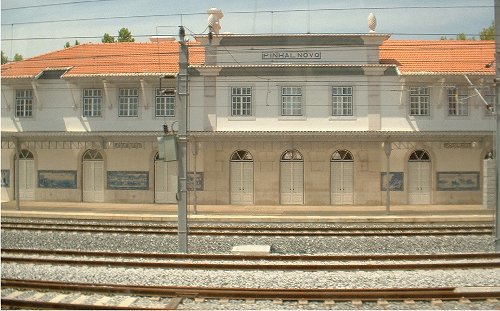
After passing a huge waste tip on the left, the beautifully tiled old station building comes into sight on the left. It has survived at the north west end of the otherwise rebuilt and enlarged, modern station at Pinhal Novo. On leaving ,the 2 Fertagus lines go right as 4 CP tracks go left.

 VENDA DO ALCAIDE (P2P)
The line passes through intermittent housing and vines with Palmela Castle still visible (right). On the left are the sidings of the Adega Cooperativa de Palmela winery.
VENDA DO ALCAIDE (P2P)
The line passes through intermittent housing and vines with Palmela Castle still visible (right). On the left are the sidings of the Adega Cooperativa de Palmela winery.

 PALMELA (P2P) The station provides good vistas of the distant hilltop castle before leaving past a water treatment works and into open country. Large silos on the right and industrial plants, then housing, signal the outskirts of Setúbal. On the left, graffiti blights the lineside.
PALMELA (P2P) The station provides good vistas of the distant hilltop castle before leaving past a water treatment works and into open country. Large silos on the right and industrial plants, then housing, signal the outskirts of Setúbal. On the left, graffiti blights the lineside.

 SETUBAL
SETUBAL
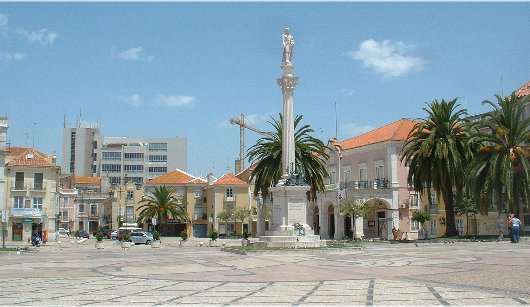
Setúbal station is about ten minutes walk from the town centre, which is reached by turning left out of the attractive station building and walking parallel to the railway line which carries on to the small halt at Praça do Quebedo (used by CP services only). Turn right at the underpass at Pç. Quebedo and walk 200 yards or so, passing the bus station on the right. A short distance beyond, turn left at the sign for the Praça Bocage (above), the attractive, pedestrianised main square of the city with its cafés, historic church and statue of the poet Bocage.
Walk on through the square for less than five minutes and you will reach the River Sado and the ferryboat terminus for boats to the beaches of the Tróia peninsula. A passenger service is operated by catamaran whilst the main car-ferry port is a few hundred yards to the left.
Copyright 2019-: ©
Compiled by John Laidlar
Contact: the following is not a link; please transcribe the address into your email 

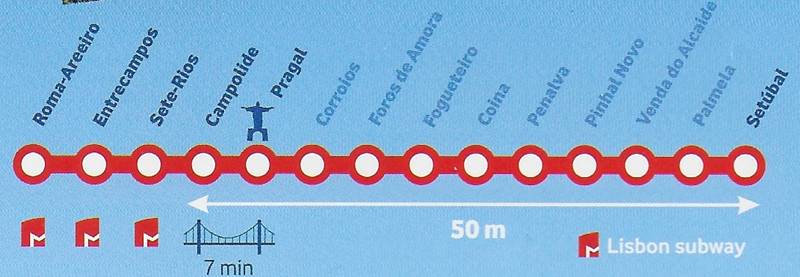
 June 2019
June 2019

 Eighteen four-car double-deck electric multiple-units (EMU) sets were ordered from GEC Alsthom by Fertagus for this route, with the Spanish (RENFE) class 450 being the basis of their design. They were built in Barcelona and their capacity is 1200 passengers per train. By November 1999, six of the eleven sets of four-cars delivered were bearing advertising liveries. All eighteen sets had been acquired by late 2000 and the majority of these train-sets initially surrendered their smart blue and white livery to commercial advertisers, a trend which had been arrested by 2005.
Eighteen four-car double-deck electric multiple-units (EMU) sets were ordered from GEC Alsthom by Fertagus for this route, with the Spanish (RENFE) class 450 being the basis of their design. They were built in Barcelona and their capacity is 1200 passengers per train. By November 1999, six of the eleven sets of four-cars delivered were bearing advertising liveries. All eighteen sets had been acquired by late 2000 and the majority of these train-sets initially surrendered their smart blue and white livery to commercial advertisers, a trend which had been arrested by 2005.

 Left and right: Fertagus services at Fogueteiro, July, 2000.
Left and right: Fertagus services at Fogueteiro, July, 2000.


 ROMA - AREEIRO
Roma-Areeiro became the new Lisbon terminus for Fertagus services c2004. The station itself is a modern enlargement of the formerly small station called Areeiro. By building a long walkway (with moving walkways), with an entrance on the Avenida de Roma (less than five minutes walk, above ground, from Roma Metro station), the new facility can claim to serve both Roma and Areeiro as it is also about a five minute walk from Areeiro Metro station. The modern station now has four tracks (P2P2) and continues to operate as a station on the
ROMA - AREEIRO
Roma-Areeiro became the new Lisbon terminus for Fertagus services c2004. The station itself is a modern enlargement of the formerly small station called Areeiro. By building a long walkway (with moving walkways), with an entrance on the Avenida de Roma (less than five minutes walk, above ground, from Roma Metro station), the new facility can claim to serve both Roma and Areeiro as it is also about a five minute walk from Areeiro Metro station. The modern station now has four tracks (P2P2) and continues to operate as a station on the 
 ENTRECAMPOS Entrecampos can be reached by CP trains from Oriente, as well as by Metro- for further details see the Luso Pages Railways Page. Both CP and Fertagus services use the station, though the latter's ticket office is poorly signposted. In fact, both companies share a facility on the level below the platforms. Fertagus trains use the platforms on the south side of the station and on departure these immediately pass Entrecampos-Poente, the terminus for the some of the services on the Sintra Line, which lie over to the right. The north side of Entrecampos station is used by CP services which include Azambuja Line trains to 08:33 04/07/2005and from Oriente and Alcântara-Terra and Sintra Line services. Some of CP's Alfa Pendular services from Faro in the Algarve also use Entrecampos.
ENTRECAMPOS Entrecampos can be reached by CP trains from Oriente, as well as by Metro- for further details see the Luso Pages Railways Page. Both CP and Fertagus services use the station, though the latter's ticket office is poorly signposted. In fact, both companies share a facility on the level below the platforms. Fertagus trains use the platforms on the south side of the station and on departure these immediately pass Entrecampos-Poente, the terminus for the some of the services on the Sintra Line, which lie over to the right. The north side of Entrecampos station is used by CP services which include Azambuja Line trains to 08:33 04/07/2005and from Oriente and Alcântara-Terra and Sintra Line services. Some of CP's Alfa Pendular services from Faro in the Algarve also use Entrecampos.

 SETE RIOS (P2P2P) Sete Rios station, seen in the adjacent aerial view, is an interchange station for CP suburban services on the Sintra line and also now is adjacent to the city's main coach station (to the right). Fertagus services share this station with CP trains. It is a modern, rebuilt station at whose western end (left) can be seen a stretch of the Lisbon aqueduct, built in the 18th century. Modern flats adorn the view to the right, whilst the left, as the station is left towards Sintra is more open, with scrubland. Sete Rios is the location of the Lisbon Zoo and there is also a nearby link to the Metro system at the Jardim Zoológico station. On the left of the Fertagus track were the former sheds of the Metro.
SETE RIOS (P2P2P) Sete Rios station, seen in the adjacent aerial view, is an interchange station for CP suburban services on the Sintra line and also now is adjacent to the city's main coach station (to the right). Fertagus services share this station with CP trains. It is a modern, rebuilt station at whose western end (left) can be seen a stretch of the Lisbon aqueduct, built in the 18th century. Modern flats adorn the view to the right, whilst the left, as the station is left towards Sintra is more open, with scrubland. Sete Rios is the location of the Lisbon Zoo and there is also a nearby link to the Metro system at the Jardim Zoológico station. On the left of the Fertagus track were the former sheds of the Metro.

 CAMPOLIDE (P2P) The cross-Tagus line uses the western side of this recently rebuilt station, with CP suburban services using the rest of the facility. A blue Fertagus train on this alignment can be seen in the upper left of the adjacent photo. CP sidings (on right in photo) house Sintra Line class 2300 and 2400 EMUs as well as class 3500 double-deck stock. The train passes under the magnificent 18th-century Aqueduto das Águas Livres (Free Waters Aqueduct) before passing a shabby area of shanties to the left. However, modern flats are also being erected nearby. The line also goes under the Viaduto Duarte Pacheco which carries road traffic towards the bridge area. The train passes through short, new platforms at an as yet unused halt (Alvito).
CAMPOLIDE (P2P) The cross-Tagus line uses the western side of this recently rebuilt station, with CP suburban services using the rest of the facility. A blue Fertagus train on this alignment can be seen in the upper left of the adjacent photo. CP sidings (on right in photo) house Sintra Line class 2300 and 2400 EMUs as well as class 3500 double-deck stock. The train passes under the magnificent 18th-century Aqueduto das Águas Livres (Free Waters Aqueduct) before passing a shabby area of shanties to the left. However, modern flats are also being erected nearby. The line also goes under the Viaduto Duarte Pacheco which carries road traffic towards the bridge area. The train passes through short, new platforms at an as yet unused halt (Alvito).

 PRAGAL (P2P2P) Seven minutes from Campolide, and only a short distance across the river, is the station of Pragal, which is also used by one or two CP services to Oporto. The station, built for the line's opening, is decorated by modern ceramic designs.
PRAGAL (P2P2P) Seven minutes from Campolide, and only a short distance across the river, is the station of Pragal, which is also used by one or two CP services to Oporto. The station, built for the line's opening, is decorated by modern ceramic designs.
 CORROIOS (P2P) After passing through a short tunnel, the town of Corroios can be seen to the left of the train which is still at a slightly higher level than the parallel road (right) at this point. Buildings are now also evident to the right where a large car-park can also be seen (for 1500 vehicles). Corroios station is entered five minutes after leaving Pragal. Sul-Fertagus and TST buses also serve this station, which has ten shops.
CORROIOS (P2P) After passing through a short tunnel, the town of Corroios can be seen to the left of the train which is still at a slightly higher level than the parallel road (right) at this point. Buildings are now also evident to the right where a large car-park can also be seen (for 1500 vehicles). Corroios station is entered five minutes after leaving Pragal. Sul-Fertagus and TST buses also serve this station, which has ten shops.

 FOROS DE AMORA (P2P) The railway is now back at street level at this high-roofed and airy station, decorated with marble and tiled walls. The motorway is to the right, parallel with the line. TST and Sul-Fertagus buses again stop outside the station, which has 23 shops and 1800 parking spaces. The town of Amora lies over to the left, on the Tagus. A tall water tank, emblasoned with 'Foros de Marinha' stands out to the left, as does a McDonald's fast-food outlet at a motorway service area to the right. Lisbon can be seen in the distance to the left.
FOROS DE AMORA (P2P) The railway is now back at street level at this high-roofed and airy station, decorated with marble and tiled walls. The motorway is to the right, parallel with the line. TST and Sul-Fertagus buses again stop outside the station, which has 23 shops and 1800 parking spaces. The town of Amora lies over to the left, on the Tagus. A tall water tank, emblasoned with 'Foros de Marinha' stands out to the left, as does a McDonald's fast-food outlet at a motorway service area to the right. Lisbon can be seen in the distance to the left.

 FOGUETEIRO (1P1P1) After leaving Foros de Amora, the line diverges from the A2 motorway as the track veers left. After two minutes, Fogueteiro station is reached. This was the terminus until 2004. The station itself is spacious, with a striking wavy roof and includes a café, news-stand and toilet facilities. There is also a Fertagus information desk. Across the road from the station are some steps to a commercial centre which includes a café overlooking the attractive station. After leaving Fogueteiro, via a small cutting, the train sweeps left, past a Sagres beer depot and semi-industrial landscape. On the left are the Fertagus sheds and sidings as the train nears Coina.
FOGUETEIRO (1P1P1) After leaving Foros de Amora, the line diverges from the A2 motorway as the track veers left. After two minutes, Fogueteiro station is reached. This was the terminus until 2004. The station itself is spacious, with a striking wavy roof and includes a café, news-stand and toilet facilities. There is also a Fertagus information desk. Across the road from the station are some steps to a commercial centre which includes a café overlooking the attractive station. After leaving Fogueteiro, via a small cutting, the train sweeps left, past a Sagres beer depot and semi-industrial landscape. On the left are the Fertagus sheds and sidings as the train nears Coina.
 COINA (1P2P1)
This is the terminus for most services, though some run on to Setúbal. In the distance (right) can be seen the hills towards Palmela. The train passes through a short tunnel before passing factory sidings (right). A line joins from the right before the train reaches Penalva.
COINA (1P2P1)
This is the terminus for most services, though some run on to Setúbal. In the distance (right) can be seen the hills towards Palmela. The train passes through a short tunnel before passing factory sidings (right). A line joins from the right before the train reaches Penalva.
 PENALVA (P2P)
This is another modern, high-roofed station with a large car-park which, as well as its Fertagus tracks under cover, also has four open-air tracks passing the station to the right. These external lines reduce to one as the train gets beyond Penalva and goes through a mixture of scrub, light industry and intermittent housing, with the town of Penalva on the left. To the right, the castle at Palmela is visible on the hill top. Now just twin-tracked again, the line passes cork trees (right) before approaching the sizeable town of Pinhal Novo, before which more lines join from the left- these come from Barreiro and were the main line CP tracks from Lisbon (via the Soflusa ferry) before the cross-Tagus bridge link was opened.
PENALVA (P2P)
This is another modern, high-roofed station with a large car-park which, as well as its Fertagus tracks under cover, also has four open-air tracks passing the station to the right. These external lines reduce to one as the train gets beyond Penalva and goes through a mixture of scrub, light industry and intermittent housing, with the town of Penalva on the left. To the right, the castle at Palmela is visible on the hill top. Now just twin-tracked again, the line passes cork trees (right) before approaching the sizeable town of Pinhal Novo, before which more lines join from the left- these come from Barreiro and were the main line CP tracks from Lisbon (via the Soflusa ferry) before the cross-Tagus bridge link was opened.


